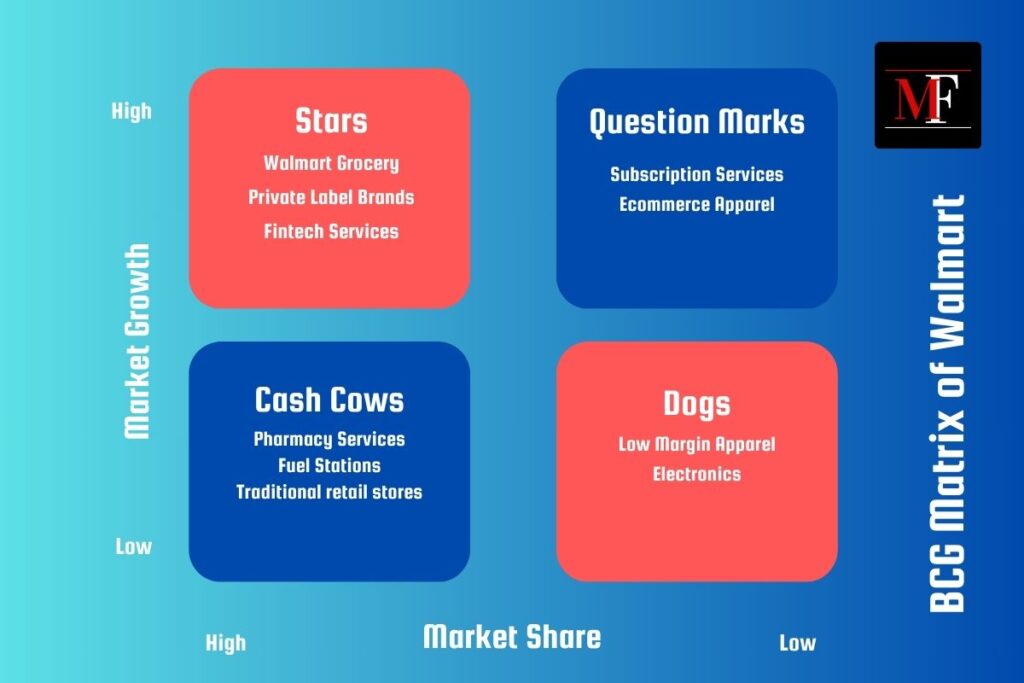The BCG Matrix, or Boston Consulting Group Growth-Share Matrix, is a well-known tool used to visualize a company’s investments. It helps categorize a company’s products or business units based on their market share and how fast the market is growing. This matrix offers a straightforward way for leaders to evaluate the different businesses and products in their company’s portfolio.
Today, we are going to analyze the BCG matrix of Walmart. Let’s start with the brief history of Walmart.
Brief History of Walmart
Walmart was founded by Sam Walton in 1962 in Rogers, Arkansas, with a mission to provide low prices and excellent value. The initial store was designed for discount retailing and quickly drew in shoppers.
During the 1970s and 1980s, Walmart grew quickly, launching numerous locations throughout the U.S. By the 1990s, it emerged as the world’s largest retailer, recognized for its effective supply chain strategies. Today, Walmart runs thousands of stores around the world and keeps evolving to meet consumer demands.
BCG Matrix of Walmart Analysis

Stars in BCG Matrix of Walmart
These are business units of products that have both high growth rates and high market shares.
When it comes to Walmart, stars include:
- Walmart Grocery: Walmart has a significant share in the fast-growing online grocery market.
- Private Label Brands (such as Great Value): These brands hold a strong market share and have the potential to grow even more in certain categories.
- FinTech Services (like MoneyGram): This sector is expanding among Walmart’s large customer base for financial services.
Cash Cows in Walmart BCG Matrix
These are business units or products that have a high market share but grow slowly.
In Walmart BCG Matrix, cash cows include:
- Pharmacy Services: They maintain a steady market share and profits.
- Traditional Retail Stores: They still bring in a lot of money even though they face competition.
- Fuel Stations: They provide a reliable source of income and attract regular customers.
Question Marks in Walmart BCG Matrix
These are business units or products with low market shares in fast-growing industries.
- E-commerce Apparel: This market is expanding, but it is competing with Amazon and other online stores.
- Subscription Services (like Walmart+): This is still in the early stages and has great growth potential, but it needs investment to succeed.
- International Expansion: There is a lot of potential here, but it also carries risks and uncertainties.
Dogs in Walmart BCG Matrix
These are business units or products with low market shares in slow-growing industries.
- Electronics (except TVs): This category is losing market share and is challenged by online retailers.
- Low-margin Apparel: This sector has a small market share and faces tough competition.
- Certain Grocery Categories (like Prepared Foods): These areas struggle with low profits or little to no growth.
Summing it up
Walmart’s BCG Matrix includes various business units categorized as Stars, Cash Cows, Question Marks, and Dogs.
- Stars like Walmart Grocery and Private Label Brands have high growth and market share.
- Cash Cows such as Pharmacy Services and Traditional Retail Stores maintain steady profits despite slow growth.
- Question Marks like E-commerce Apparel show potential but face competition.
- Dogs, including certain Electronics and Low-margin Apparel, have low market share in slow-growing markets.
